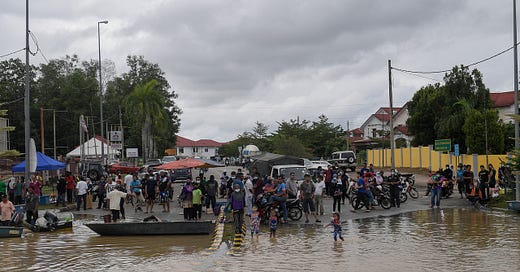Climate change is bringing and will bring more storms, heat waves, and weird weather
Cyclones, hurricanes, and other storms are on the increase
Climate change will bring more floods to Malaysia
On December 16th of last year, a tropical depression brought heavy rains to Malaysia, the deadliest cyclone-related disaster since Tropical Storm Greg pummeled the Southeast Asian country in 1996. Downpours persisted for three days. In one day alone, over 14 inches of rain were recorded in a 24-hour period. At least 54 people died in some of the worst flooding to ever hit the country. Malaysian officials declared Greg a “once in a century” disaster.
But due to climate change, another storm of similar magnitude may hit Malaysia in less than 100 years. Climate scientists looked at the the effects of climate change on Southeast Asia, specifically, Malaysia, and more specifically the watershed for Temenggor Lake, which is in the central portion of the peninsular portion of Malaysia. The scientists published their work in the journal Theoretical and Applied Climatology in January of this year.
Malaysia is tropical and surrounded by seas. As such, there is no dry season, and there are frequent typhoons that cause intense downpours. Most of the country, the peninsula or the island, is drenched with 79 inches of rain each year. That’s twice the rainfall that New York City gets, more than three times of what Seattle gets.
Temenggor is a man-made lake that cobwebs through the upland terrain of the Malaysian peninsula. The Temenggor Dam, a hydroelectric project built in the 1970s, created the lake. A central concern of the scientific paper is the strain that increased rainfall might have on the dam as well as other infrastructure.
Floods throughout the world are predicted to increase because of global warming. Previous research indicates that the tropics are more sensitive to global heating than most temperate regions. For most tropics, a one degree Celsius rise in global temperature results in ten percent heavier rainfall throughout the tropics.

The scientists looked at a number of factors, the southern oscillation and the Atlantic multi-decadal oscillation, in conjunction with the warming waters of the seas around Malaysia. They predict that big floods, the kind that hit Malaysia in December, will increase by almost half as much (48.5%) from 2031 through 2045 for the Temenggor watershed. Looking further into the future, 2060 through 2075, the big floods are predicted to more than double, increasing by 122.6 percent. The scientists point out that these increases have important implications for Temenggor Dam, which is over 40 years old, and other infrastructure in the watershed.
And there are more hurricanes in the Atlantic
Over the last 40 years, the Atlantic has been spawning more and more hurricanes. This has correlated with increased temperatures due to global warming, yet scientists have has a hard time making a cause and effect connection because there is a lot of year-to-year fluctuation in hurricanes. There are modeling difficulties as well.
With a paper published in Weather and Climate Dynamics, scientist have now shown that increases in the temperature of the Atlantic’s surface waters, as well as variations in atmospheric circulation, have doubled the probability of extremely active hurricane seasons.
The authors say that these more frequent storms are exacerbated because climate driven storms drop more rain. Storm surges are also worsened by the sea level rise. The authors of the paper warn:
Our findings indicate that warming SSTs [sea surface temperature] over the tropical Atlantic might have already contributed significantly to more extreme tropical cyclone seasons and thereby to the fatalities, destruction and trillion dollar losses that these cyclones have caused over the last four decades. Given the projected increases in SSTs with increasing warming, our findings suggest that the probability of extreme seasons might further increase. To minimize future risks, stringent emission reductions in line with achieving the goals of the Paris Agreement would be required.
Chaud, caliente, goraco, no matter how you say it, Europe has gotten a lot hotter
While the global average temperature increase amounts to 1.2 degrees Celsius, Europe has warmed by about two full degrees, what scientists have described as the danger threshold.
For Europe, the summer of 2021 was the warmest on record, with a heatwave along the shores of the Mediterranean. On August 11 of last year, Sicily experienced the highest temperature ever recorded in Europe, a blistering 120 degrees Fahrenheit. High temperatures helped to bring about deadly wildfires in Greece.
Climate change is making much of Europe’s weather unstable. In 2018, from February through November, Germany experienced an extreme drought. In the fall of 2018, rainfall in most of Germany was 51 percent less than normal. And just last year, in July, Belgium and Germany experienced record breaking rainfalls and were besieged by floods in which more than 70 individuals died.
India and Pakistan now swelter in heat
Right now India and Pakistan are sweltering through an unusual string of heatwaves, with temperatures reaching 115 degrees. Fire has become more of a danger; crops are threatened; and the melting of some glaciers has accelerated. Extreme heat has always been more common in the Asian subcontinent, but scientists are convinced that the more extreme heatwaves are a product of global heating.
For more environmental science & news follow me on Twitter @EcoScripsit.




